2020 SUBARU BRZ traction control
[x] Cancel search: traction controlPage 19 of 560

BRZ_U
19
Scrapping of your SUBARU
The SRS airbag and seatbelt pretensioner devices in your SUBARU contain
explosive chemicals. If the vehicle is scrapped with the airbags and seatbelt
pretensioners left as they are, this may cause an accident such as fire. Be
sure to have the systems of the SRS airbag and seatbelt pretensioner
removed and disposed of by a qualified service shop or by your SUBARU
dealer before you scrap your vehicle.
Perchlorate Material
Special handling may apply, See www.dtsc.ca.gov/hazardouswaste/perchlorate.
Your vehicle has components that may contain perchlorate. These
components may include airbag, seatbelt pretensioners, and transmitter
batteries.
WARNING
■ General precautions while driving
Driving under the influence: Never drive your vehicle when under the influ-
ence of alcohol or drugs that have impa ired your ability to operate your vehi-
cle. Alcohol and certain drugs delay reaction time, impair judgment and
reduce coordination, which could lead to an accident that could result in
death or serious injury.
Defensive driving: Always drive defensively. Anticipate mistakes that other
drivers or pedestrians might make and be ready to avoid accidents.
Driver distraction: Always give your full attention to driving. Anything that dis-
tracts the driver, such as adjusting controls, talking on a cellular phone or
reading can result in a collision with resulting death or serious injury to you,
your occupants or others.
■ General precaution regarding children’s safety
Never leave children unattended in the vehicle, and never allow children to
have or use the key.
Children may be able to start the vehicle or shift the vehicle into neutral.
There is also a danger that children may injure themselves by playing with
the windows or other features of the vehicle. In addition, heat build-up or
extremely cold temperatures inside the vehicle can be fatal to children.
Page 205 of 560
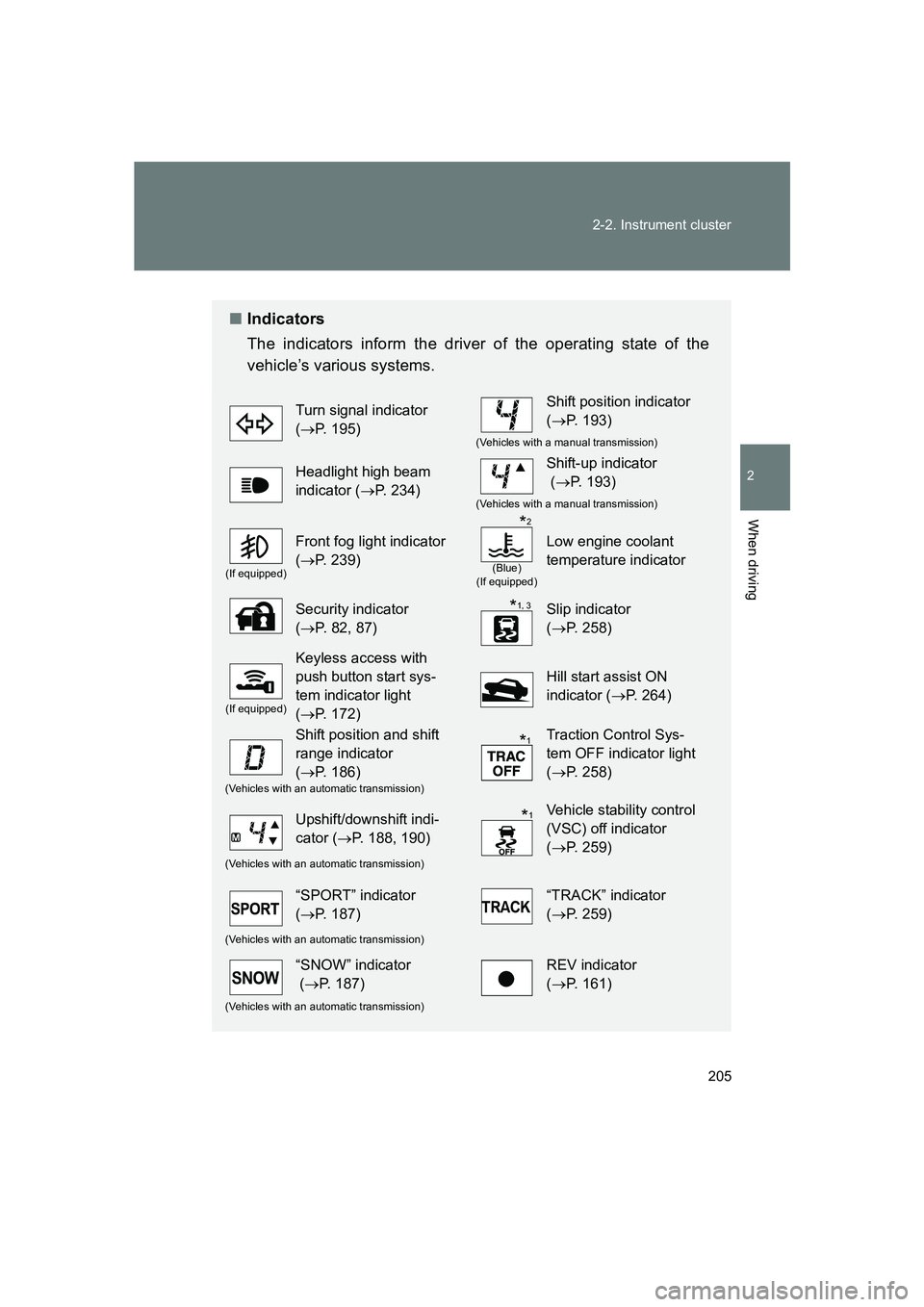
205
2-2. Instrument cluster
2
When driving
BRZ_U
■
Indicators
The indicators inform the driver of the operating state of the
vehicle’s various systems.
Turn signal indicator
(→ P. 195)Shift position indicator
(→ P. 193)
(Vehicles with a manual transmission)
Headlight high beam
indicator ( →P. 234)Shift-up indicator
(→ P. 193)
(Vehicles with a manual transmission)
(If equipped)
Front fog light indicator
(→ P. 239)
(Blue)
(If equipped)
Low engine coolant
temperature indicator
Security indicator
( → P. 82, 87)Slip indicator
(→ P. 258)
(If equipped)
Keyless access with
push button start sys-
tem indicator light
(→ P. 172)
Hill start assist ON
indicator ( →P. 264)
Shift position and shift
range indicator
(→ P. 186)Traction Control Sys-
tem OFF indicator light
(→ P. 258)
(Vehicles with an automatic transmission)
Upshift/downshift indi-
cator ( →P. 188, 190)Vehicle stability control
(VSC) off indicator
(→ P. 259)
(Vehicles with an automatic transmission)
“SPORT” indicator
(→ P. 187)“TRACK” indicator
(→ P. 259)
(Vehicles with an automatic transmission)
“SNOW” indicator
(→ P. 187)REV indicator
(→ P. 161)
(Vehicles with an automatic transmission)
*2
*1, 3
*1
*1
Page 257 of 560
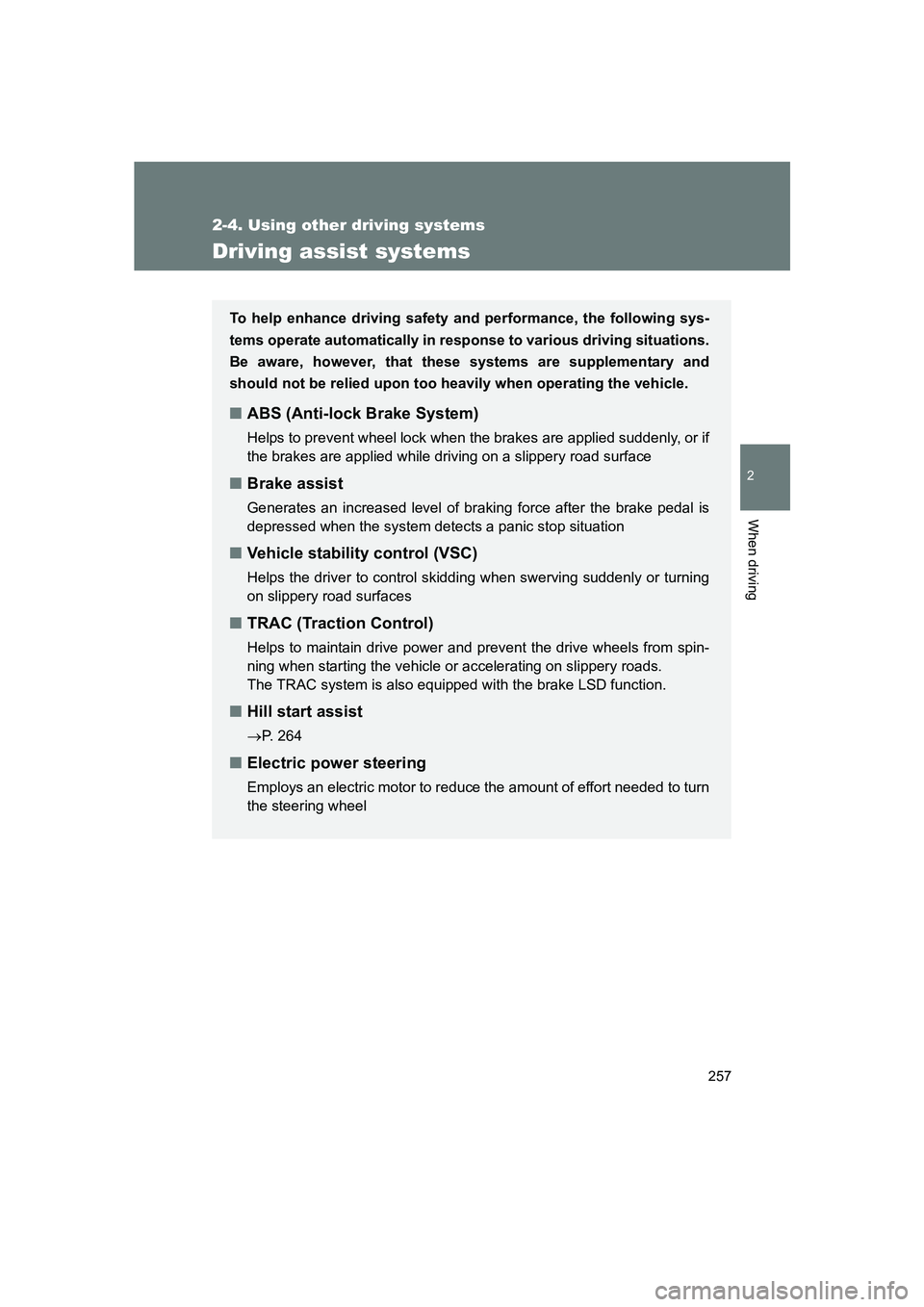
257
2-4. Using other driving systems
2
When driving
BRZ_U
Driving assist systems
To help enhance driving safety and performance, the following sys-
tems operate automatically in response to various driving situations.
Be aware, however, that these systems are supplementary and
should not be relied upon too heavily when operating the vehicle.
■ ABS (Anti-lock Brake System)
Helps to prevent wheel lock when the brakes are applied suddenly, or if
the brakes are applied while driving on a slippery road surface
■Brake assist
Generates an increased level of braking force after the brake pedal is
depressed when the system detects a panic stop situation
■Vehicle stability control (VSC)
Helps the driver to control skidding when swerving suddenly or turning
on slippery road surfaces
■TRAC (Traction Control)
Helps to maintain drive power and pr event the drive wheels from spin-
ning when starting the vehicle or accelerating on slippery roads.
The TRAC system is also equipped with the brake LSD function.
■ Hill start assist
→P. 264
■ Electric power steering
Employs an electric motor to reduce the amount of effort needed to turn
the steering wheel
Page 258 of 560
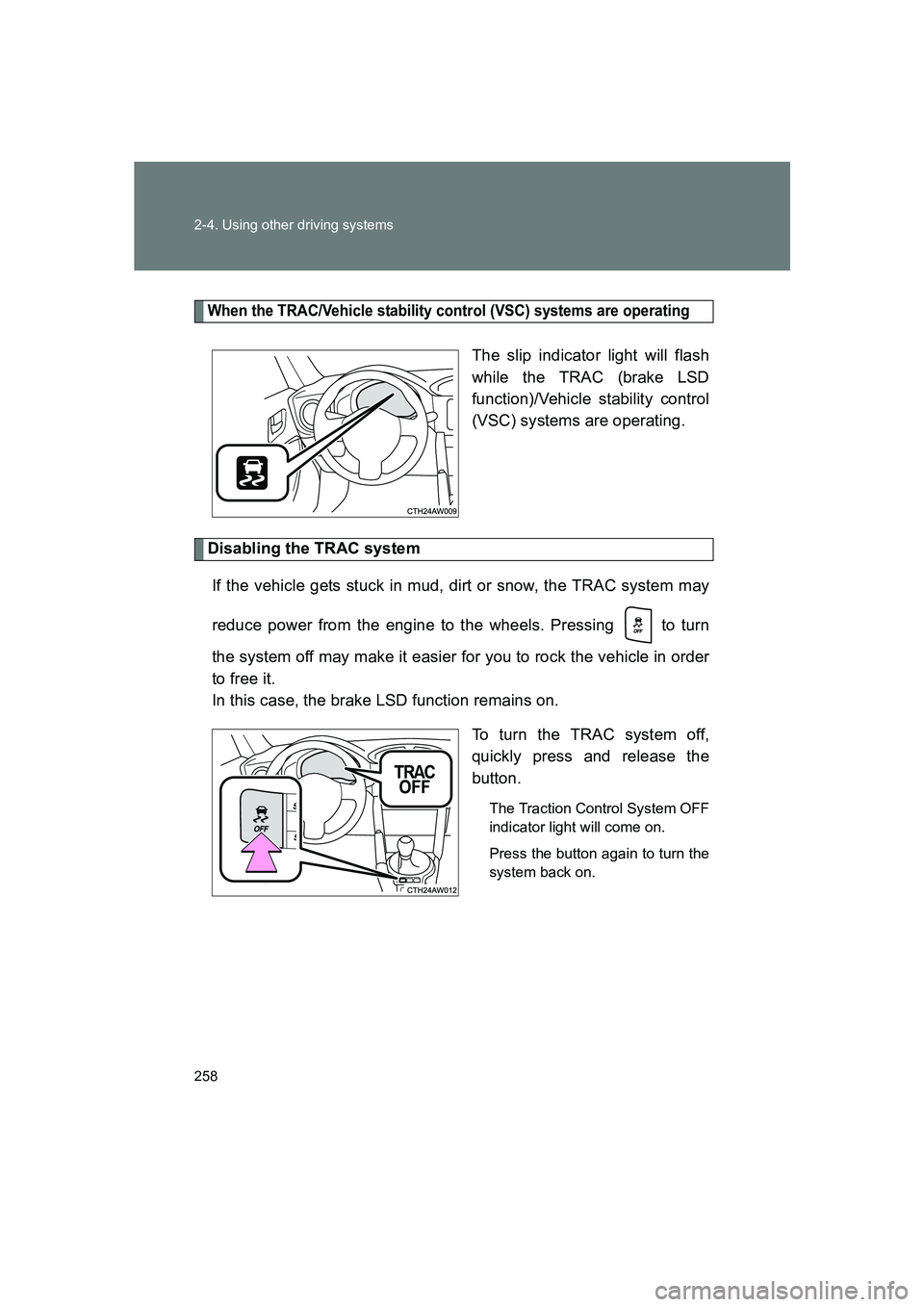
258 2-4. Using other driving systems
BRZ_U
When the TRAC/Vehicle stability control (VSC) systems are operating
The slip indicator light will flash
while the TRAC (brake LSD
function)/Vehicle stability control
(VSC) systems are operating.
Disabling the TRAC system
If the vehicle gets stuck in mud, dirt or snow, the TRAC system may
reduce power from the engine to the wheels. Pressing to turn
the system off may make it easier for you to rock the vehicle in order
to free it.
In this case, the brake LSD function remains on. To turn the TRAC system off,
quickly press and release the
button.
The Traction Control System OFF
indicator light will come on.
Press the button again to turn the
system back on.
Page 259 of 560
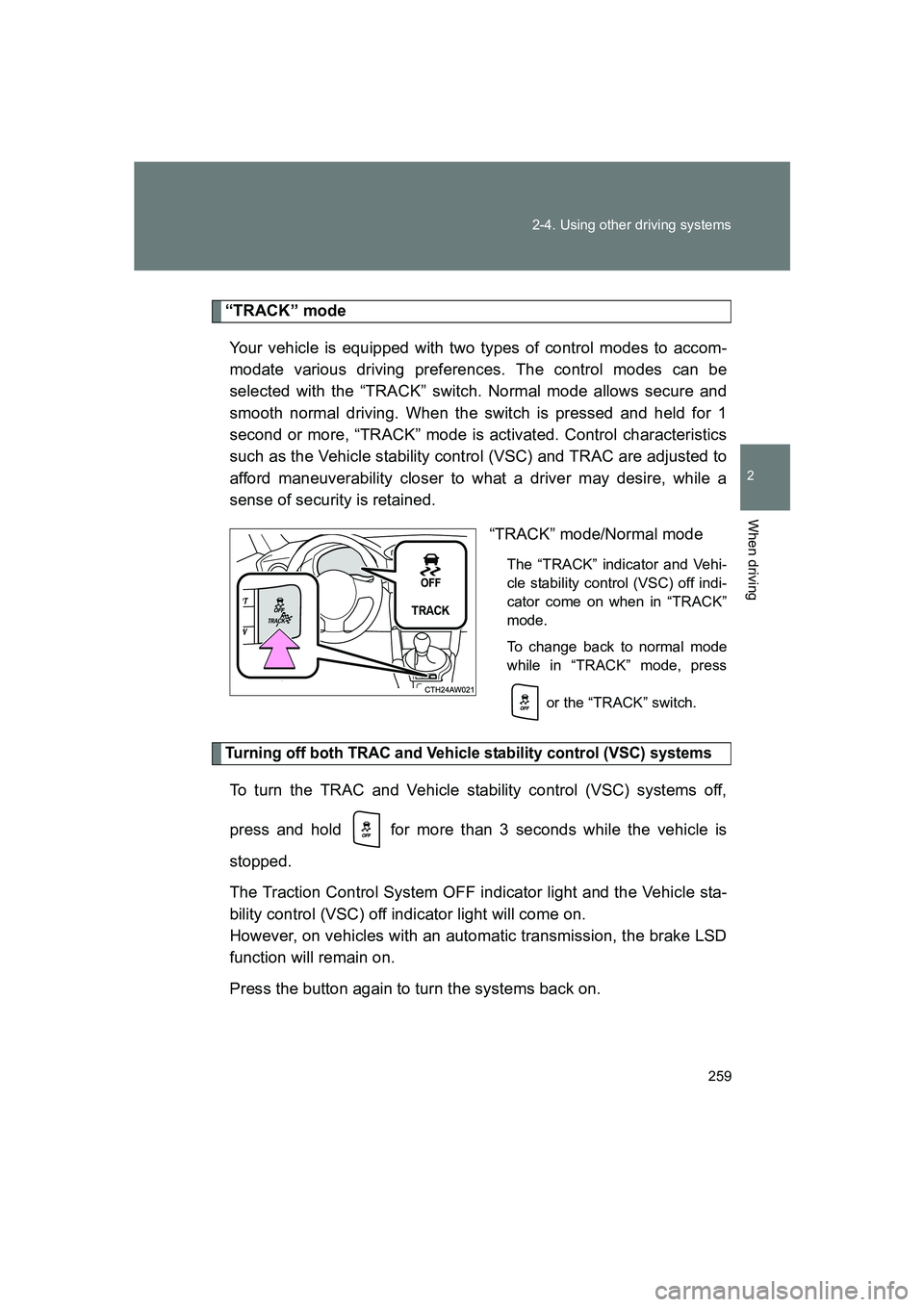
259
2-4. Using other driving systems
2
When driving
BRZ_U
“TRACK” mode
Your vehicle is equipped with two types of control modes to accom-
modate various driving preferences. The control modes can be
selected with the “TRACK” switch. Normal mode allows secure and
smooth normal driving. When the switch is pressed and held for 1
second or more, “TRACK” mode is activated. Control characteristics
such as the Vehicle stability control (VSC) and TRAC are adjusted to
afford maneuverability closer to what a driver may desire, while a
sense of security is retained. “TRACK” mode/Normal mode
The “TRACK” indicator and Vehi-
cle stability control (VSC) off indi-
cator come on when in “TRACK”
mode.
To change back to normal mode
while in “TRACK” mode, press
or the “TRACK” switch.
Turning off both TRAC and Vehicle stability control (VSC) systems
To turn the TRAC and Vehicle stability control (VSC) systems off,
press and hold for more than 3 seconds while the vehicle is
stopped.
The Traction Control System OFF indicator light and the Vehicle sta-
bility control (VSC) off indicator light will come on.
However, on vehicles with an automatic transmission, the brake LSD
function will remain on.
Press the button again to turn the systems back on.
Page 264 of 560
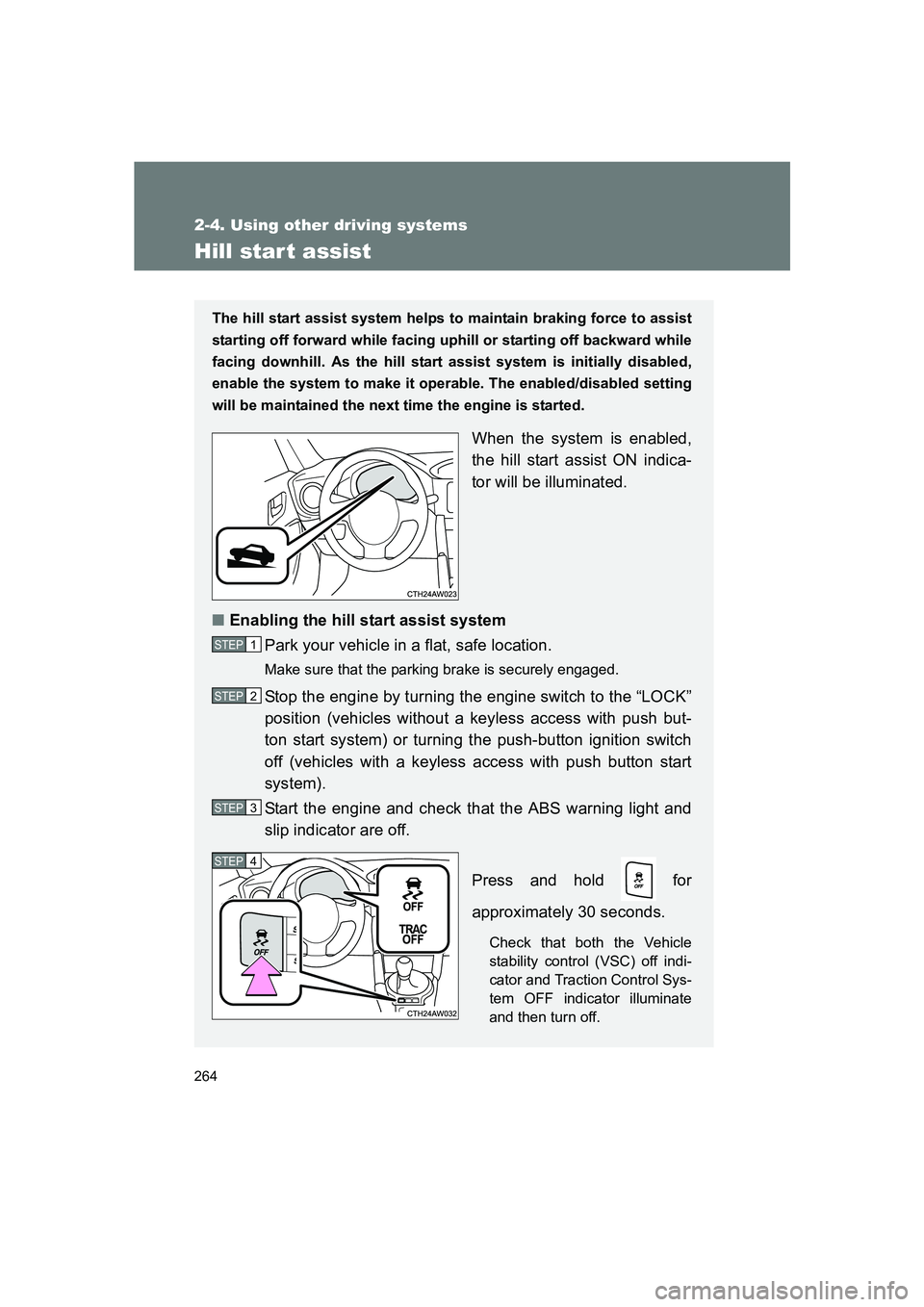
264
2-4. Using other driving systems
BRZ_U
Hill star t assist
The hill start assist system helps to maintain braking force to assist
starting off forward while facing uphill or starting off backward while
facing downhill. As the hill start assist system is initially disabled,
enable the system to make it oper able. The enabled/disabled setting
will be maintained the next time the engine is started.
When the system is enabled,
the hill start assist ON indica-
tor will be illuminated.
■ Enabling the hill start assist system
Park your vehicle in a flat, safe location.
Make sure that the parking brake is securely engaged.
Stop the engine by turning the engine switch to the “LOCK”
position (vehicles without a keyless access with push but-
ton start system) or turning the push-button ignition switch
off (vehicles with a keyless access with push button start
system).
Start the engine and check that the ABS warning light and
slip indicator are off.
Press and hold for
approximately 30 seconds.
Check that both the Vehicle
stability control (VSC) off indi-
cator and Traction Control Sys-
tem OFF indicator illuminate
and then turn off.
STEP 1
STEP 2
STEP 3
STEP 4
Page 266 of 560
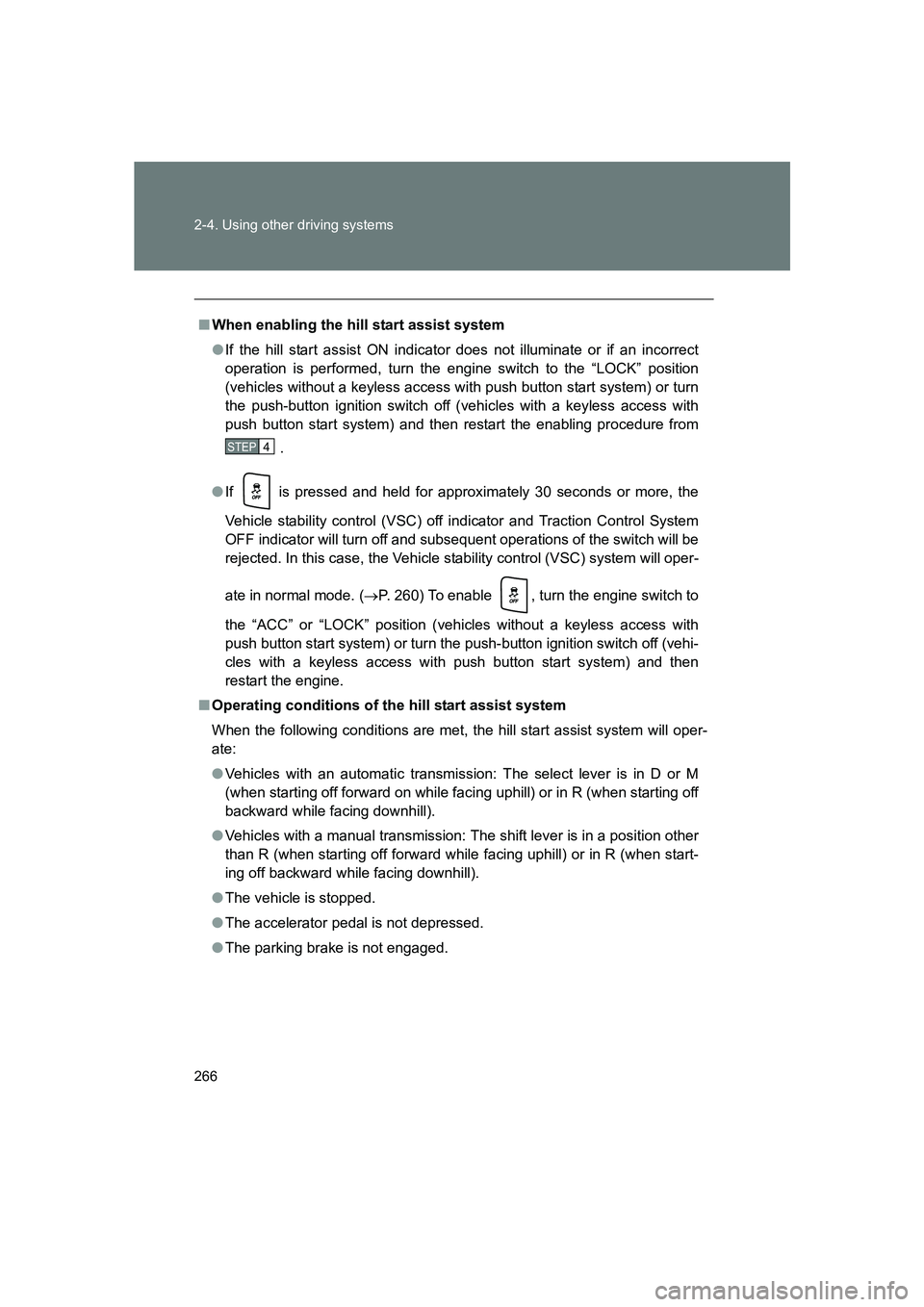
266 2-4. Using other driving systems
BRZ_U
■When enabling the hill start assist system
●If the hill start assist ON indicator does not illuminate or if an incorrect
operation is performed, turn the engine switch to the “LOCK” position
(vehicles without a keyless access with push button start system) or turn
the push-button ignition switch off (vehicles with a keyless access with
push button start system) and then restart the enabling procedure from
.
● If is pressed and held for approximately 30 seconds or more, the
Vehicle stability control (VSC) off indicator and Traction Control System
OFF indicator will turn off and subsequent operations of the switch will be
rejected. In this case, the Vehicle stability control (VSC) system will oper-
ate in normal mode. ( →P. 260) To enable , turn the engine switch to
the “ACC” or “LOCK” position (vehicles without a keyless access with
push button start system) or turn the push-button ignition switch off (vehi-
cles with a keyless access with push button start system) and then
restart the engine.
■ Operating conditions of the hill start assist system
When the following conditions are met, t he hill start assist system will oper-
ate:
● Vehicles with an automatic transmission: The select lever is in D or M
(when starting off forward on while facing uphill) or in R (when starting off
backward while facing downhill).
● Vehicles with a manual transmission: The shift lever is in a position other
than R (when starting off forward while facing uphill) or in R (when start-
ing off backward while facing downhill).
● The vehicle is stopped.
● The accelerator pedal is not depressed.
● The parking brake is not engaged.
STEP 4
Page 510 of 560
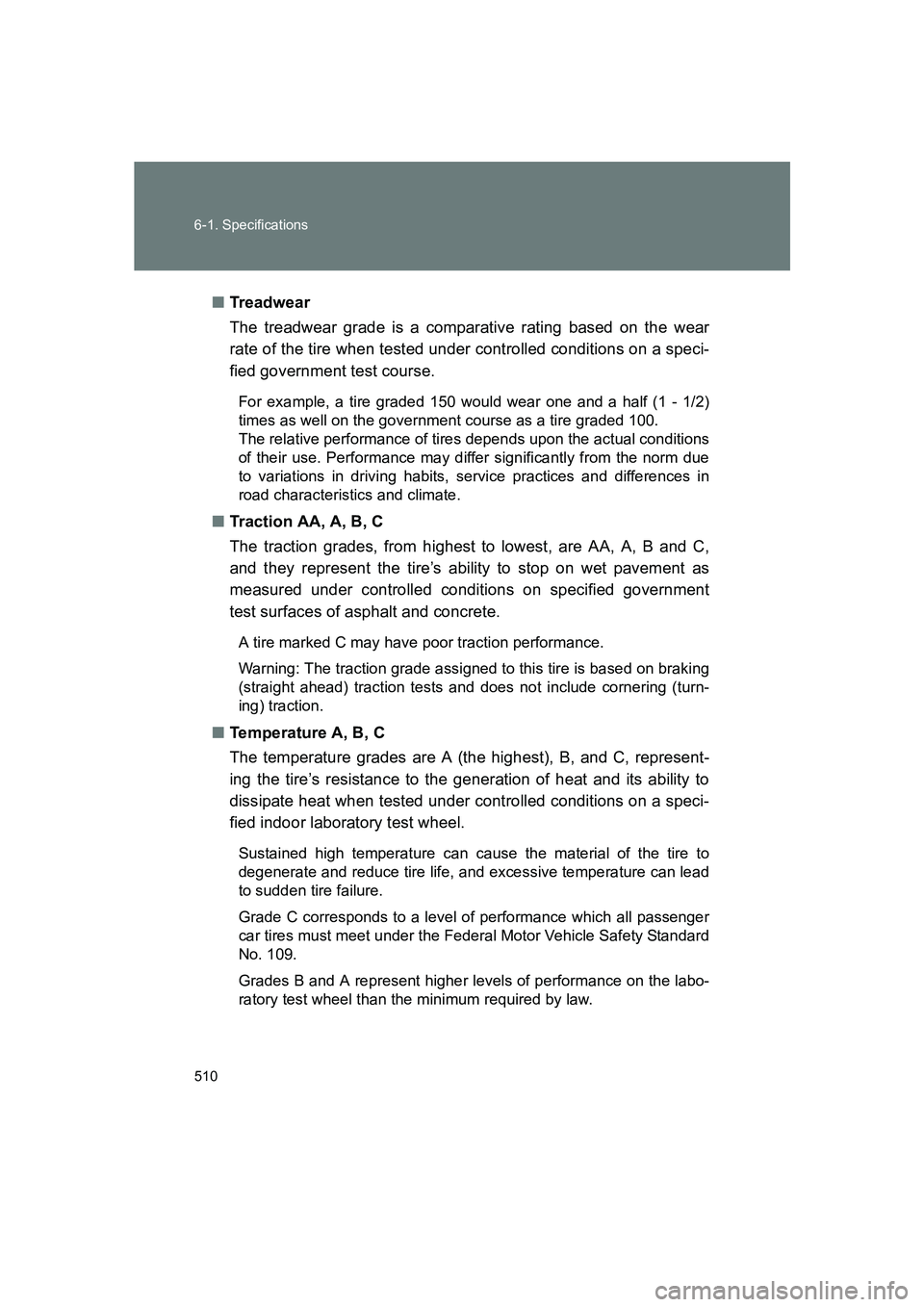
510 6-1. Specifications
BRZ_U■
Tre ad w ea r
The treadwear grade is a comparative rating based on the wear
rate of the tire when tested under controlled conditions on a speci-
fied government test course.
For example, a tire graded 150 would wear one and a half (1 - 1/2)
times as well on the government course as a tire graded 100.
The relative performance of tires depends upon the actual conditions
of their use. Performance may differ significantly from the norm due
to variations in driving habits, service practices and differences in
road characteristics and climate.
■Traction AA, A, B, C
The traction grades, from highest to lowest, are AA, A, B and C,
and they represent the tire’s ability to stop on wet pavement as
measured under controlled conditions on specified government
test surfaces of asphalt and concrete.
A tire marked C may have poor traction performance.
Warning: The traction grade assigned to this tire is based on braking
(straight ahead) traction tests and does not include cornering (turn-
ing) traction.
■Temperature A, B, C
The temperature grades are A (the highest), B, and C, represent-
ing the tire’s resistance to the generation of heat and its ability to
dissipate heat when tested under controlled conditions on a speci-
fied indoor laboratory test wheel.
Sustained high temperature can cause the material of the tire to
degenerate and reduce tire life, and excessive temperature can lead
to sudden tire failure.
Grade C corresponds to a level of performance which all passenger
car tires must meet under the Federal Motor Vehicle Safety Standard
No. 109.
Grades B and A represent higher levels of performance on the labo-
ratory test wheel than the minimum required by law.